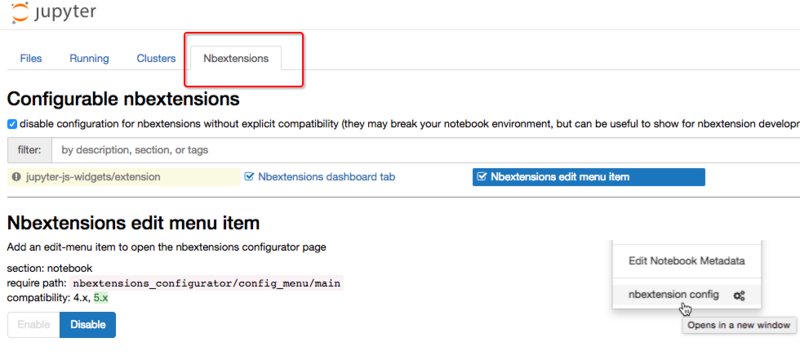强烈建议在Virtualenv虚拟环境下使用pip安装,这样就不需要什么sudo或--user之类的了,也不会搞乱系统级的配置。
一键安装所有东西:
# 安装插件配置器
pip install jupyter_nbextensions_configurator
jupyter nbextensions_configurator enable
# 安装所有插件包
pip install jupyter_contrib_nbextensions
jupyter contrib nbextension install
# 安装所有主题
pip install jupyterthemes
1. 安装插件管理器 Jupyter Nbextensions Configurator
Refer to Github page.
# 安装Jupyter的配置器
$ pip install jupyter_nbextensions_configurator
# 启动配置器
$ jupyter nbextensions_configurator enable --user装好后,输入jupyter notebook命令打开网页,就会发现多出一个栏目:
2. 安装插件包 Jupyter-extensions
# 下载所有插件包
pip install jupyter_contrib_nbextensions
# 安装下载的插件包
jupyter contrib nbextension install3. 安装颜色主题 Jupyter-themes
参考:Github jupyter-themes
安装:
$ pip install jupyterthemes
$ pip install --upgrade jupyterthemes使用方法:Jupyter-themes实际上是一个命令行的命令工具,切换主题的话需要用命令行来执行。安装好后,就可以用jt命令来执行。
以下是常用的命令:
# 查看所有颜色主题 --list
$ jt -l
# 选择主题 --theme
$ jt -t 主题名称
# 恢复默认主题 --recover
$ jt -r4. 使用Sublime Text快捷键
Jupyter固然好用,但是直接在里面写代码真的很烦,效率还没有直接在记事本里面高。
所以非常有必要设定为Sublime Text的快捷键,加速编程效率。
参考:把Jupyter Notebook配置成Coding神器(Windows)
参考:在 Notebook 中使用 Sublime Text 快捷键
主要方法就是新建(或修改)~/.jupyter/custom/custom.js文件,加入这么一段运行命令:
require(["codemirror/keymap/sublime", "notebook/js/cell", "base/js/namespace"],
function(sublime_keymap, cell, IPython) {
// setTimeout(function(){ // uncomment line to fake race-condition
cell.Cell.options_default.cm_config.keyMap = 'sublime';
var cells = IPython.notebook.get_cells();
for(var cl=0; cl< cells.length ; cl++){
cells[cl].code_mirror.setOption('keyMap', 'sublime');
}
// }, 1000)// uncomment line to fake race condition
}
);保存退出然后刷新Jupyter页面即可。
亲测即使是在Virtualenv虚拟环境中运行的Jupyter,也会识别同样的这个文件。
如果本地的custom.js不在那个位置,那么就需要在Jupyter里面运行一段代码来检查位置在哪里了:
# 打印 Jupyter 配置目录的路径
from jupyter_core.paths import jupyter_config_dir
jupyter_dir = jupyter_config_dir()
print(jupyter_dir)
# 打印 custom.js 的路径
import os.path
custom_js_path = os.path.join(jupyter_dir, 'custom', 'custom.js')
print(custom_js_path)
# 如果 custom.js 文件存在,打印其内容
if os.path.isfile(custom_js_path):
with open(custom_js_path) as f:
print(f.read())
else:
print("You don't have a custom.js file")完成后,快捷键如下:
Ctrl+ L 选择一行(连续选取多行)
Ctrl+ D 选择当前变量(或重复选择并编辑)
Ctrl+ Shift+ M 选择括号里面的内容
Ctrl+ Shift+ K
或 Ctrl+ X 删除一行
Ctrl+ K K 删除本行光标后的所有内容
Ctrl+ Shift+ D 快速复制一行
Ctrl+ K U 大写
Ctrl+ K L 小写
Ctrl+ / 注释
Ctrl+ Tab 代码提示,可以连续多按最后
以上就是苗条雪糕最近收集整理的关于 Jupyter Notebook 安装插件的全部内容,更多相关内容请搜索靠谱客的其他文章。
本图文内容来源于网友提供,作为学习参考使用,或来自网络收集整理,版权属于原作者所有。








发表评论 取消回复